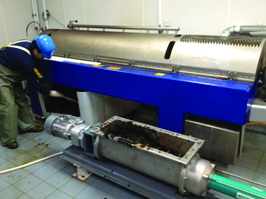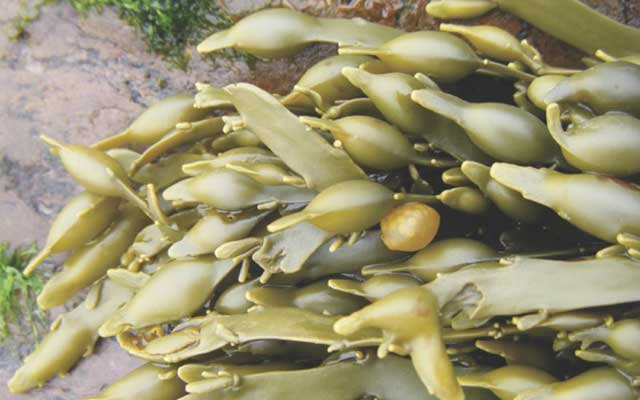Custom-designed pump solution improves process cleanliness and efficiency
A plant that processes hard-to-handle seaweed into agricultural fertilizer products needed a cleaner and more efficient solution for conveying the viscous seaweed extract for packaging. The company reached out to NETZSCH for a custom solution. Following a successful trial of a NETZSCH progressing cavity pump in the process, the customer implemented a NEMO® BF progressing cavity pump, which has improved cleanliness and efficiency with low total cost of ownership.
Efficient conveying system sought for seaweed processing plant
A Quebec-based company that specializes in the manufacturing and commercialization of marine and seaweed-based products for agriculture and horticulture constructed a new processing plant located in the maritime region of the lower St. Lawrence River in Quebec, Canada. This location provides easy access to the fresh marine raw materials the company needs, specifically, the seaweed Ascophyllum nodosum.
The seaweed is harvested by tractor at low tide, with areas worked on a rotating basis in order to allow for continual regrowth. After harvesting, the seaweed is dried on-site at the manufacturing plant in greenhouses to ensure optimal preservation of the raw material, which is ultimately processed into high-quality crop fertilizer and soil amendments.
In processing the seaweed, the raw product is mixed with hot water and caustic solution in an 11,000-liter (3,000-gallon) tank until the lengths of seaweed dissolve. From the tank, the liquid is transferred by a NETZSCH NEMO® progressing cavity pump into a centrifuge, where the solution is dewatered.
After the seaweed mixture is dewatered, the remaining seaweed extract is very viscous. This extract has a thick, sticky gelatinous consistency somewhere between solid and liquid. At this point in processing, the extract also has a high pH value, and is approximately 90˚C (195˚F).
In designing the new processing plant, the company wanted to install a piece of production equipment capable of conveying the high-temperature, alkaline dewatered seaweed extract from the centrifuge to packaging areas in the plant, and chose to install conveying equipment on a trial basis. The company first tested a conveyor positioned at the discharge of the centrifuge; however, the open nature and inflexibility of the conveyor solution, which decreased efficiency and led to strong smells during production, led the company to seek an alternative solution.
Manufacturer looks to NETZSCH for a custom solution
The customer reached out to NETZSCH for a custom pump solution to replace the conveyor system due to the success of the NEMO progressive cavity pump used for feeding the centrifuge. NETZSCH engineers supplied a trial NEMO BF pump to the processing plant to be used at the outlet of the centrifuge. During the course of this 60-day trial, the NETZSCH team discovered that the trial pump was able to handle the system pressure, even when the customer chose to split the discharge hose and serve two packaging areas. In doing so, the NETZSCH pump eliminated need for separate batches serving the same purpose, thereby increasing production efficiencies.

From the tank, the liquid is transferred by a NETZSCH NEMO® progressing cavity pump into a centrifuge, where the solution is dewatered.
NEMO BF pump selected for service
Ultimately, the customer selected the NETZSCH NEMO BF pump for this application. This specific pump is used in all branches of industry to provide continuous, pressure-stable, gentle and low-pulsation conveyance with dosing in proportion to rotation speed. It is employed primarily for highly viscous, compacted and crumbly substances that do not have a tendency to bridge.
The customer’s final pump selection was based on the trial with the demo pump, which provided valuable insight into process challenges. Another major factor in this customer selecting the NETZSCH equipment was the on-site consultation provided by NETZSCH sales engineers, during which they provided troubleshooting about the consistency of the end product.
The NEMO BF pump selected for this seaweed processing application features an open hopper design in stainless steel construction with a special feed screw, and a stainless steel rotor suitable for 90˚C (195˚F). The patented design of the pump feed screw overfeeds the pump chamber by introducing a backflow through the gap between the feed screw and the hopper housing, thereby creating a mixing and homogenizing effect in the force-feed chamber. Additionally, the screw rises above the joints on both the drive side and the rotor side, thus avoiding dead areas in the joint region. This unique feed screw design allows the NETZSCH pump to succeed in this application where other pumps could not.
The customer also requested an EPDM food-grade stator and packed stuffing box, which NETZSCH supplied. The pump was installed with a right angle 10 hp inverter duty gear motor with severe duty protection, a 10 hp VFD controller with coupling, and guard mounted on a 304 stainless steel base plate with a stainless steel 3” to 2” tri-clamp discharge connection.
NEMO pump improves conveying efficiency
With the NETZSCH pump, the customer is now able to cleanly and efficiently move product throughout the plant to different packaging areas. In contrast to the open conveying system that was originally in place, the closed piping included in the NETZSCH pumping solution eliminates production odors. The NETZSCH open hopper pump was installed in late summer 2013, delivering exactly the performance that the trial pump demonstrated, and it has run smoothly since its installation.




